Business Development AS1 Portfolio Report: Global Market Analysis
VerifiedAdded on 2023/01/06
|9
|2416
|95
Report
AI Summary
This report provides an overview of globalization, internationalization, and market expansion strategies. It begins by defining globalization and internationalization, highlighting their significance for businesses seeking to expand globally. The report then explores the concept of the global market, emphasizing the 'think globally, act locally' strategy, and provides the example of Tesco Plc. The report further delves into the BRIC countries, with a specific focus on the opportunities and challenges presented by the Chinese market, including its political risks and competitive landscape. The report also examines market expansion strategies, comparing the waterfall and shower approaches. The report concludes by summarizing the key concepts and findings, emphasizing the importance of adapting business strategies to succeed in the global market.

AS1- PORTFOLIO
Paraphrase This Document
Need a fresh take? Get an instant paraphrase of this document with our AI Paraphraser
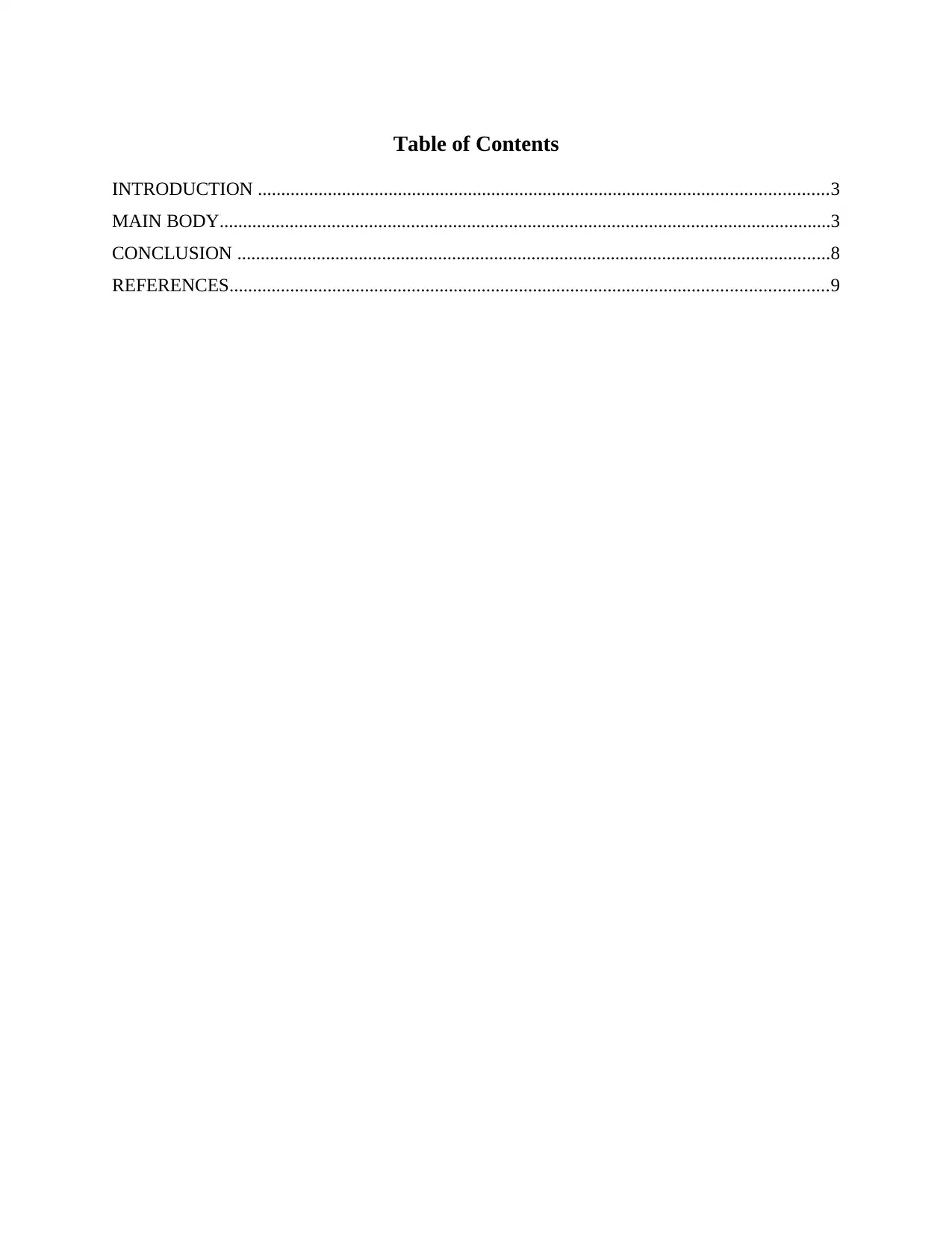
Table of Contents
INTRODUCTION ..........................................................................................................................3
MAIN BODY...................................................................................................................................3
CONCLUSION ...............................................................................................................................8
REFERENCES................................................................................................................................9
INTRODUCTION ..........................................................................................................................3
MAIN BODY...................................................................................................................................3
CONCLUSION ...............................................................................................................................8
REFERENCES................................................................................................................................9
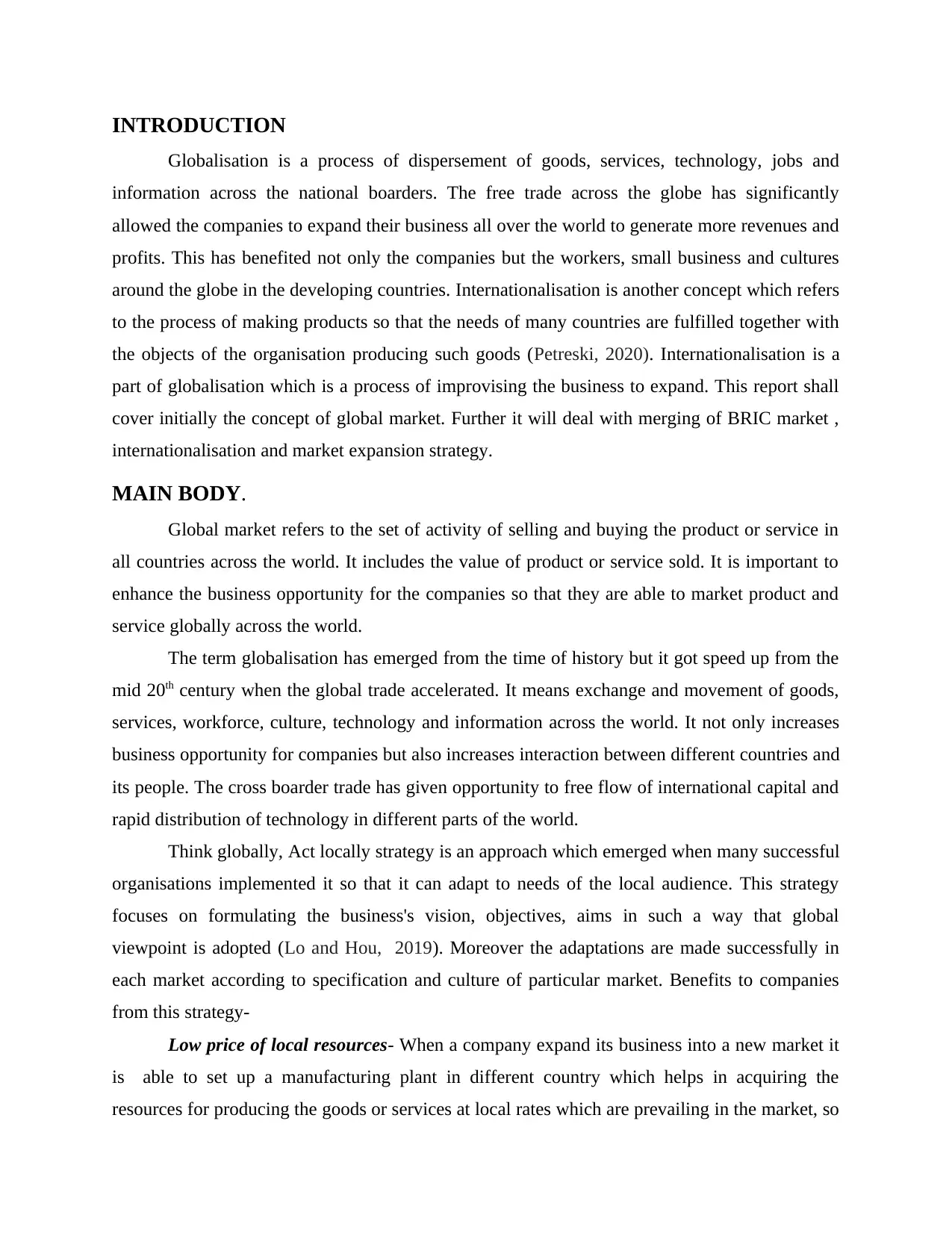
INTRODUCTION
Globalisation is a process of dispersement of goods, services, technology, jobs and
information across the national boarders. The free trade across the globe has significantly
allowed the companies to expand their business all over the world to generate more revenues and
profits. This has benefited not only the companies but the workers, small business and cultures
around the globe in the developing countries. Internationalisation is another concept which refers
to the process of making products so that the needs of many countries are fulfilled together with
the objects of the organisation producing such goods (Petreski, 2020). Internationalisation is a
part of globalisation which is a process of improvising the business to expand. This report shall
cover initially the concept of global market. Further it will deal with merging of BRIC market ,
internationalisation and market expansion strategy.
MAIN BODY.
Global market refers to the set of activity of selling and buying the product or service in
all countries across the world. It includes the value of product or service sold. It is important to
enhance the business opportunity for the companies so that they are able to market product and
service globally across the world.
The term globalisation has emerged from the time of history but it got speed up from the
mid 20th century when the global trade accelerated. It means exchange and movement of goods,
services, workforce, culture, technology and information across the world. It not only increases
business opportunity for companies but also increases interaction between different countries and
its people. The cross boarder trade has given opportunity to free flow of international capital and
rapid distribution of technology in different parts of the world.
Think globally, Act locally strategy is an approach which emerged when many successful
organisations implemented it so that it can adapt to needs of the local audience. This strategy
focuses on formulating the business's vision, objectives, aims in such a way that global
viewpoint is adopted (Lo and Hou, 2019). Moreover the adaptations are made successfully in
each market according to specification and culture of particular market. Benefits to companies
from this strategy-
Low price of local resources- When a company expand its business into a new market it
is able to set up a manufacturing plant in different country which helps in acquiring the
resources for producing the goods or services at local rates which are prevailing in the market, so
Globalisation is a process of dispersement of goods, services, technology, jobs and
information across the national boarders. The free trade across the globe has significantly
allowed the companies to expand their business all over the world to generate more revenues and
profits. This has benefited not only the companies but the workers, small business and cultures
around the globe in the developing countries. Internationalisation is another concept which refers
to the process of making products so that the needs of many countries are fulfilled together with
the objects of the organisation producing such goods (Petreski, 2020). Internationalisation is a
part of globalisation which is a process of improvising the business to expand. This report shall
cover initially the concept of global market. Further it will deal with merging of BRIC market ,
internationalisation and market expansion strategy.
MAIN BODY.
Global market refers to the set of activity of selling and buying the product or service in
all countries across the world. It includes the value of product or service sold. It is important to
enhance the business opportunity for the companies so that they are able to market product and
service globally across the world.
The term globalisation has emerged from the time of history but it got speed up from the
mid 20th century when the global trade accelerated. It means exchange and movement of goods,
services, workforce, culture, technology and information across the world. It not only increases
business opportunity for companies but also increases interaction between different countries and
its people. The cross boarder trade has given opportunity to free flow of international capital and
rapid distribution of technology in different parts of the world.
Think globally, Act locally strategy is an approach which emerged when many successful
organisations implemented it so that it can adapt to needs of the local audience. This strategy
focuses on formulating the business's vision, objectives, aims in such a way that global
viewpoint is adopted (Lo and Hou, 2019). Moreover the adaptations are made successfully in
each market according to specification and culture of particular market. Benefits to companies
from this strategy-
Low price of local resources- When a company expand its business into a new market it
is able to set up a manufacturing plant in different country which helps in acquiring the
resources for producing the goods or services at local rates which are prevailing in the market, so
⊘ This is a preview!⊘
Do you want full access?
Subscribe today to unlock all pages.

Trusted by 1+ million students worldwide
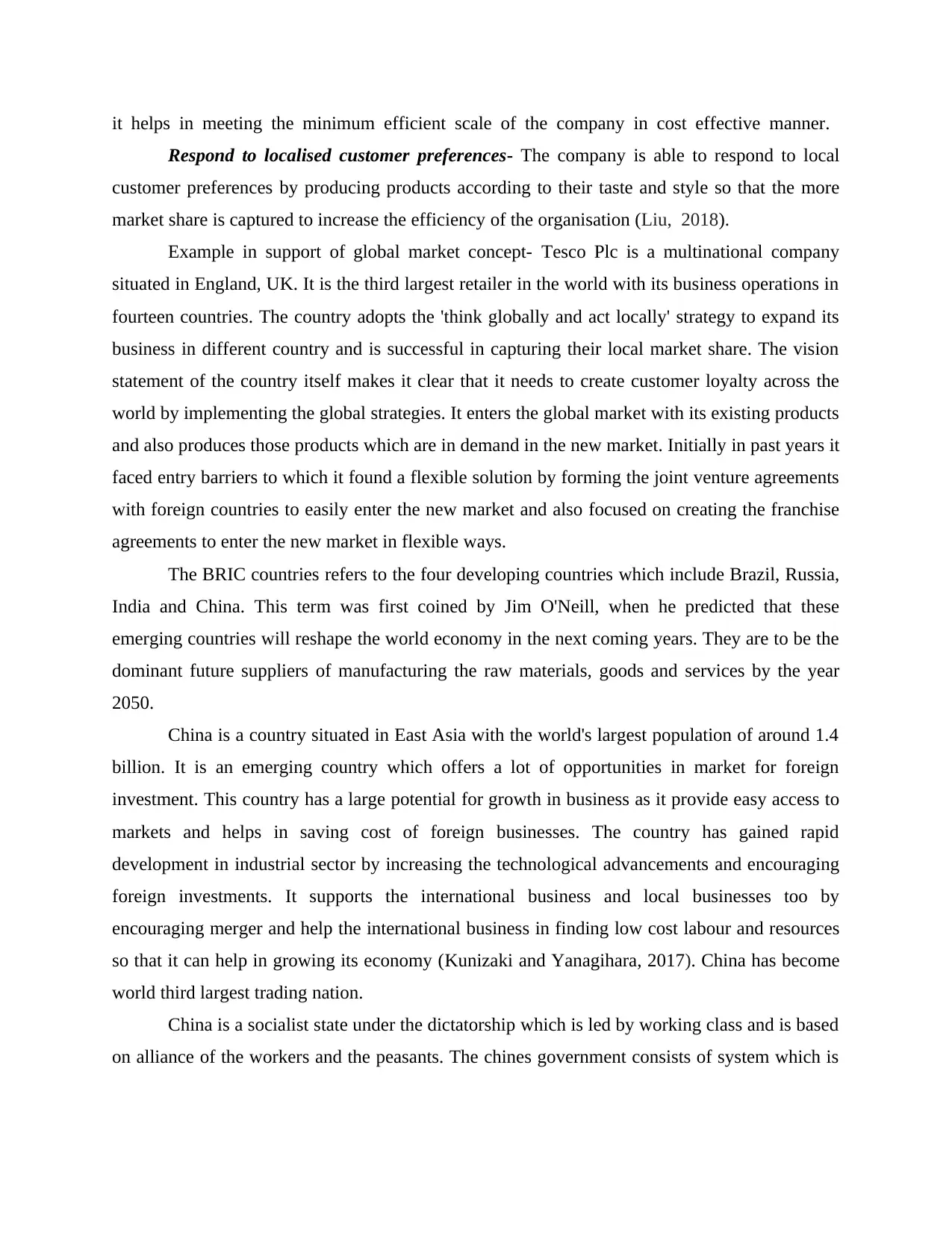
it helps in meeting the minimum efficient scale of the company in cost effective manner.
Respond to localised customer preferences- The company is able to respond to local
customer preferences by producing products according to their taste and style so that the more
market share is captured to increase the efficiency of the organisation (Liu, 2018).
Example in support of global market concept- Tesco Plc is a multinational company
situated in England, UK. It is the third largest retailer in the world with its business operations in
fourteen countries. The country adopts the 'think globally and act locally' strategy to expand its
business in different country and is successful in capturing their local market share. The vision
statement of the country itself makes it clear that it needs to create customer loyalty across the
world by implementing the global strategies. It enters the global market with its existing products
and also produces those products which are in demand in the new market. Initially in past years it
faced entry barriers to which it found a flexible solution by forming the joint venture agreements
with foreign countries to easily enter the new market and also focused on creating the franchise
agreements to enter the new market in flexible ways.
The BRIC countries refers to the four developing countries which include Brazil, Russia,
India and China. This term was first coined by Jim O'Neill, when he predicted that these
emerging countries will reshape the world economy in the next coming years. They are to be the
dominant future suppliers of manufacturing the raw materials, goods and services by the year
2050.
China is a country situated in East Asia with the world's largest population of around 1.4
billion. It is an emerging country which offers a lot of opportunities in market for foreign
investment. This country has a large potential for growth in business as it provide easy access to
markets and helps in saving cost of foreign businesses. The country has gained rapid
development in industrial sector by increasing the technological advancements and encouraging
foreign investments. It supports the international business and local businesses too by
encouraging merger and help the international business in finding low cost labour and resources
so that it can help in growing its economy (Kunizaki and Yanagihara, 2017). China has become
world third largest trading nation.
China is a socialist state under the dictatorship which is led by working class and is based
on alliance of the workers and the peasants. The chines government consists of system which is
Respond to localised customer preferences- The company is able to respond to local
customer preferences by producing products according to their taste and style so that the more
market share is captured to increase the efficiency of the organisation (Liu, 2018).
Example in support of global market concept- Tesco Plc is a multinational company
situated in England, UK. It is the third largest retailer in the world with its business operations in
fourteen countries. The country adopts the 'think globally and act locally' strategy to expand its
business in different country and is successful in capturing their local market share. The vision
statement of the country itself makes it clear that it needs to create customer loyalty across the
world by implementing the global strategies. It enters the global market with its existing products
and also produces those products which are in demand in the new market. Initially in past years it
faced entry barriers to which it found a flexible solution by forming the joint venture agreements
with foreign countries to easily enter the new market and also focused on creating the franchise
agreements to enter the new market in flexible ways.
The BRIC countries refers to the four developing countries which include Brazil, Russia,
India and China. This term was first coined by Jim O'Neill, when he predicted that these
emerging countries will reshape the world economy in the next coming years. They are to be the
dominant future suppliers of manufacturing the raw materials, goods and services by the year
2050.
China is a country situated in East Asia with the world's largest population of around 1.4
billion. It is an emerging country which offers a lot of opportunities in market for foreign
investment. This country has a large potential for growth in business as it provide easy access to
markets and helps in saving cost of foreign businesses. The country has gained rapid
development in industrial sector by increasing the technological advancements and encouraging
foreign investments. It supports the international business and local businesses too by
encouraging merger and help the international business in finding low cost labour and resources
so that it can help in growing its economy (Kunizaki and Yanagihara, 2017). China has become
world third largest trading nation.
China is a socialist state under the dictatorship which is led by working class and is based
on alliance of the workers and the peasants. The chines government consists of system which is
Paraphrase This Document
Need a fresh take? Get an instant paraphrase of this document with our AI Paraphraser
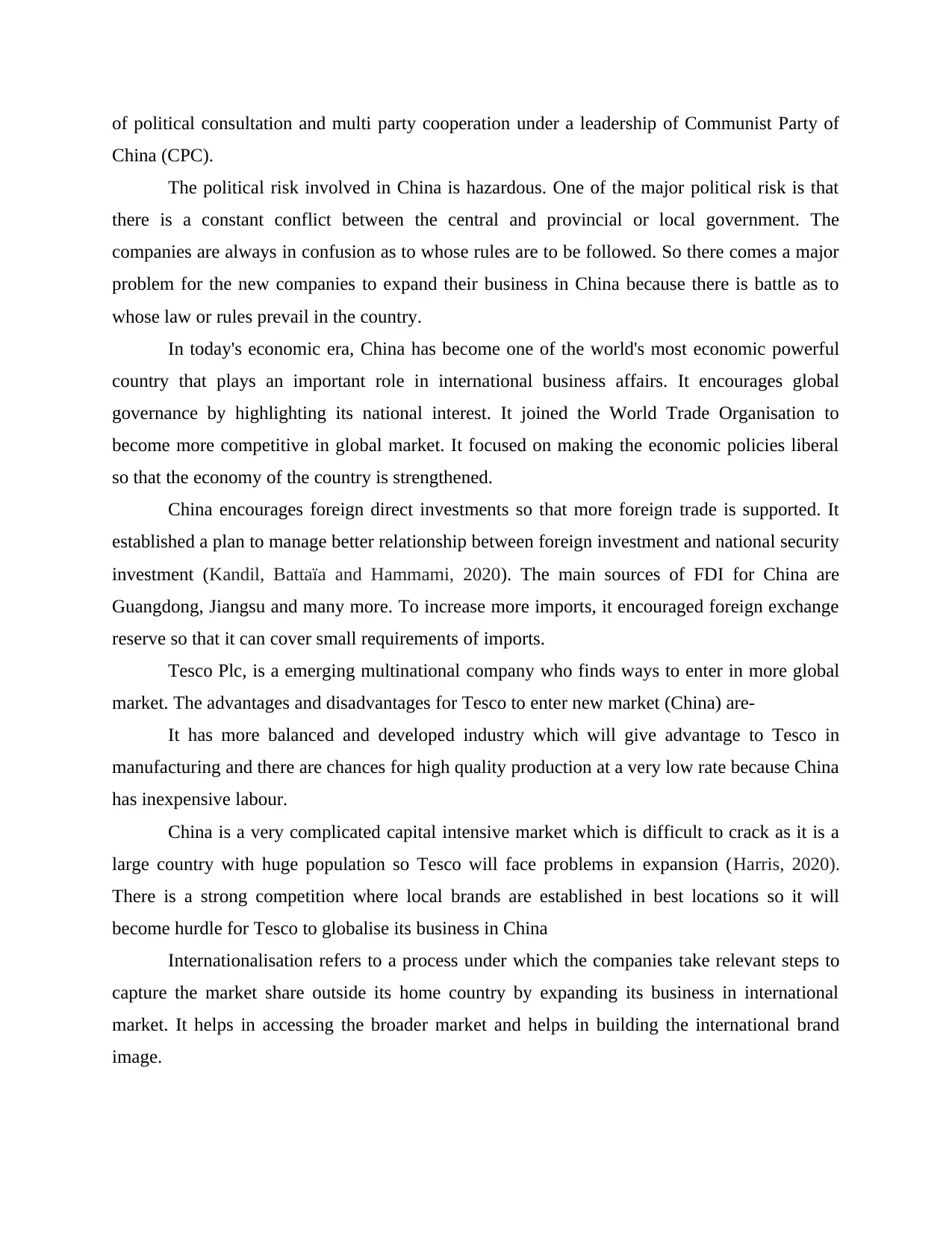
of political consultation and multi party cooperation under a leadership of Communist Party of
China (CPC).
The political risk involved in China is hazardous. One of the major political risk is that
there is a constant conflict between the central and provincial or local government. The
companies are always in confusion as to whose rules are to be followed. So there comes a major
problem for the new companies to expand their business in China because there is battle as to
whose law or rules prevail in the country.
In today's economic era, China has become one of the world's most economic powerful
country that plays an important role in international business affairs. It encourages global
governance by highlighting its national interest. It joined the World Trade Organisation to
become more competitive in global market. It focused on making the economic policies liberal
so that the economy of the country is strengthened.
China encourages foreign direct investments so that more foreign trade is supported. It
established a plan to manage better relationship between foreign investment and national security
investment (Kandil, Battaïa and Hammami, 2020). The main sources of FDI for China are
Guangdong, Jiangsu and many more. To increase more imports, it encouraged foreign exchange
reserve so that it can cover small requirements of imports.
Tesco Plc, is a emerging multinational company who finds ways to enter in more global
market. The advantages and disadvantages for Tesco to enter new market (China) are-
It has more balanced and developed industry which will give advantage to Tesco in
manufacturing and there are chances for high quality production at a very low rate because China
has inexpensive labour.
China is a very complicated capital intensive market which is difficult to crack as it is a
large country with huge population so Tesco will face problems in expansion (Harris, 2020).
There is a strong competition where local brands are established in best locations so it will
become hurdle for Tesco to globalise its business in China
Internationalisation refers to a process under which the companies take relevant steps to
capture the market share outside its home country by expanding its business in international
market. It helps in accessing the broader market and helps in building the international brand
image.
China (CPC).
The political risk involved in China is hazardous. One of the major political risk is that
there is a constant conflict between the central and provincial or local government. The
companies are always in confusion as to whose rules are to be followed. So there comes a major
problem for the new companies to expand their business in China because there is battle as to
whose law or rules prevail in the country.
In today's economic era, China has become one of the world's most economic powerful
country that plays an important role in international business affairs. It encourages global
governance by highlighting its national interest. It joined the World Trade Organisation to
become more competitive in global market. It focused on making the economic policies liberal
so that the economy of the country is strengthened.
China encourages foreign direct investments so that more foreign trade is supported. It
established a plan to manage better relationship between foreign investment and national security
investment (Kandil, Battaïa and Hammami, 2020). The main sources of FDI for China are
Guangdong, Jiangsu and many more. To increase more imports, it encouraged foreign exchange
reserve so that it can cover small requirements of imports.
Tesco Plc, is a emerging multinational company who finds ways to enter in more global
market. The advantages and disadvantages for Tesco to enter new market (China) are-
It has more balanced and developed industry which will give advantage to Tesco in
manufacturing and there are chances for high quality production at a very low rate because China
has inexpensive labour.
China is a very complicated capital intensive market which is difficult to crack as it is a
large country with huge population so Tesco will face problems in expansion (Harris, 2020).
There is a strong competition where local brands are established in best locations so it will
become hurdle for Tesco to globalise its business in China
Internationalisation refers to a process under which the companies take relevant steps to
capture the market share outside its home country by expanding its business in international
market. It helps in accessing the broader market and helps in building the international brand
image.

One of the motive that causes the company to internationalise is Market seekers. This
motive focuses on demand. If the company seeks importance in accessing to target market
which are in abroad and believes that it is important for the target market to internationalise its
company then it focus on market seekers. The organisations that invest with an intention to
supply products or service to a particular nation are called market seekers. The main reason for
internationalisation is when companies want to invest in foreign market to explore the new
market to generate more profits (Grochal-Brejdak and Szymura-Tyc, 2018). One of the example
for this is Apple company, which has expanded its business in other countries due to increase in
demand. So to fulfil the demands of the target market, it decided to internationalise its business.
One of the trigger that causes a company to internationalise is competition. Due to
increase in the level of competitors around the globe, the organisation feels pressurised to expand
the market share in international market so that it can create the brand image across the world
which helps in easy brand recognition. A need to earn more profit sometimes forces companies
to internationalise by selling more goods in the international market as they were unable to sell it
in their home country. So to maintain their stability and brand image, it is important for
companies to internationalise. Example for this is Microsoft. It internationalise its business to
compete with Apple to launch a new laptop, namely Microsoft Surface so that it can capture the
market share of Apple.
Market expansion strategies are also called the business growth strategies. These are
adopted by the companies who want to explore new market after getting growth in the existing
markets or who wish to achieve more growth as compared to past growth. There are two
strategies discussed-
Waterfall Approach- It is a process which creates deliverables in linear sequence. It
breaks a project into many phases and each phase is to be timely completed as the other is
dependent on the previous phase to begin. This approach helps in taking advantage of the
market. The main roll out in this approach is to initially introduce a new product in home country
then in advanced market and at last in the less advanced market. Its main benefit is that the
company with less resources can begin their internationalise process in phased manner and can
move step by step in each market and if there is disapproval for the product, it has an advantage
to quit the market and step out from the process easily.
motive focuses on demand. If the company seeks importance in accessing to target market
which are in abroad and believes that it is important for the target market to internationalise its
company then it focus on market seekers. The organisations that invest with an intention to
supply products or service to a particular nation are called market seekers. The main reason for
internationalisation is when companies want to invest in foreign market to explore the new
market to generate more profits (Grochal-Brejdak and Szymura-Tyc, 2018). One of the example
for this is Apple company, which has expanded its business in other countries due to increase in
demand. So to fulfil the demands of the target market, it decided to internationalise its business.
One of the trigger that causes a company to internationalise is competition. Due to
increase in the level of competitors around the globe, the organisation feels pressurised to expand
the market share in international market so that it can create the brand image across the world
which helps in easy brand recognition. A need to earn more profit sometimes forces companies
to internationalise by selling more goods in the international market as they were unable to sell it
in their home country. So to maintain their stability and brand image, it is important for
companies to internationalise. Example for this is Microsoft. It internationalise its business to
compete with Apple to launch a new laptop, namely Microsoft Surface so that it can capture the
market share of Apple.
Market expansion strategies are also called the business growth strategies. These are
adopted by the companies who want to explore new market after getting growth in the existing
markets or who wish to achieve more growth as compared to past growth. There are two
strategies discussed-
Waterfall Approach- It is a process which creates deliverables in linear sequence. It
breaks a project into many phases and each phase is to be timely completed as the other is
dependent on the previous phase to begin. This approach helps in taking advantage of the
market. The main roll out in this approach is to initially introduce a new product in home country
then in advanced market and at last in the less advanced market. Its main benefit is that the
company with less resources can begin their internationalise process in phased manner and can
move step by step in each market and if there is disapproval for the product, it has an advantage
to quit the market and step out from the process easily.
⊘ This is a preview!⊘
Do you want full access?
Subscribe today to unlock all pages.

Trusted by 1+ million students worldwide
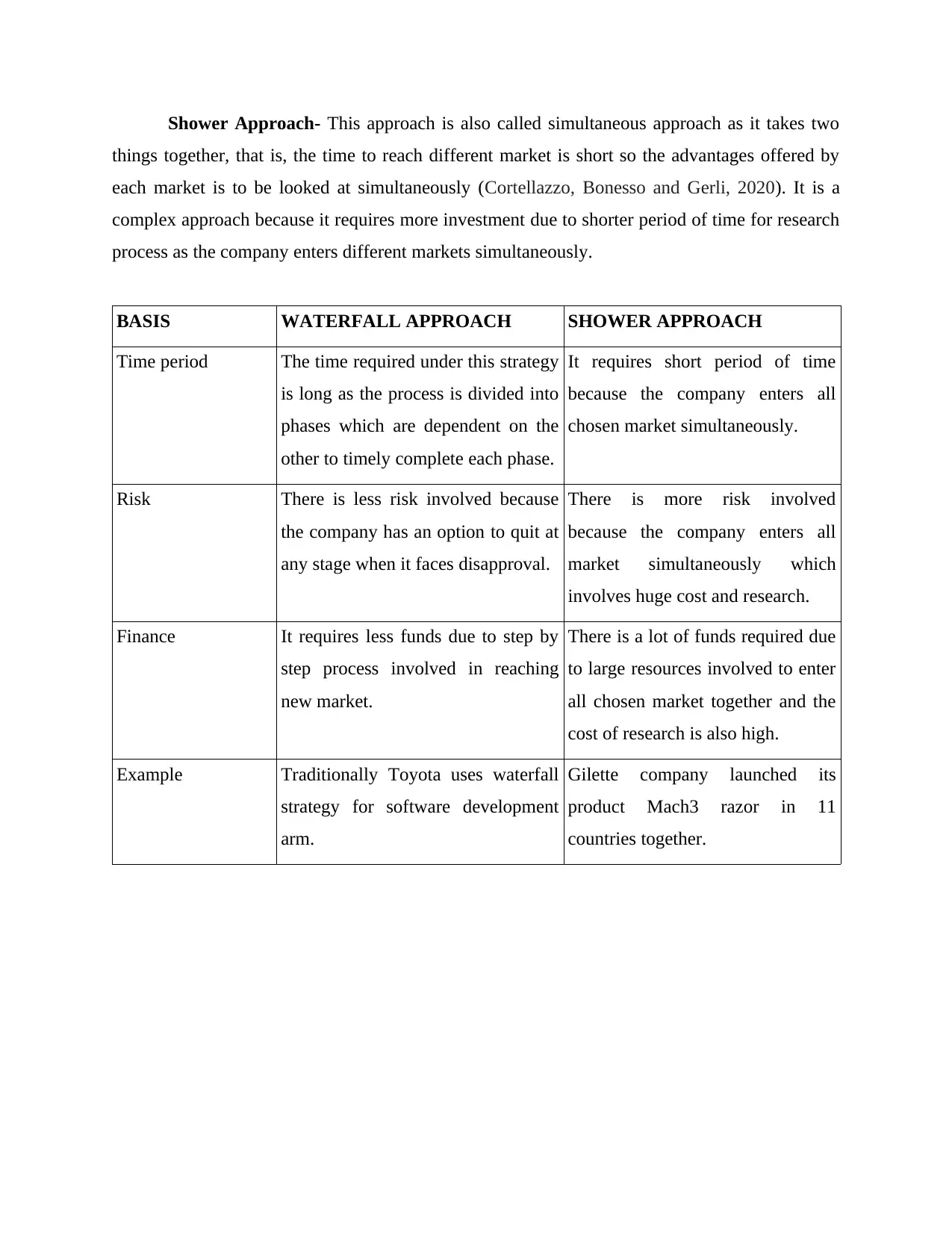
Shower Approach- This approach is also called simultaneous approach as it takes two
things together, that is, the time to reach different market is short so the advantages offered by
each market is to be looked at simultaneously (Cortellazzo, Bonesso and Gerli, 2020). It is a
complex approach because it requires more investment due to shorter period of time for research
process as the company enters different markets simultaneously.
BASIS WATERFALL APPROACH SHOWER APPROACH
Time period The time required under this strategy
is long as the process is divided into
phases which are dependent on the
other to timely complete each phase.
It requires short period of time
because the company enters all
chosen market simultaneously.
Risk There is less risk involved because
the company has an option to quit at
any stage when it faces disapproval.
There is more risk involved
because the company enters all
market simultaneously which
involves huge cost and research.
Finance It requires less funds due to step by
step process involved in reaching
new market.
There is a lot of funds required due
to large resources involved to enter
all chosen market together and the
cost of research is also high.
Example Traditionally Toyota uses waterfall
strategy for software development
arm.
Gilette company launched its
product Mach3 razor in 11
countries together.
things together, that is, the time to reach different market is short so the advantages offered by
each market is to be looked at simultaneously (Cortellazzo, Bonesso and Gerli, 2020). It is a
complex approach because it requires more investment due to shorter period of time for research
process as the company enters different markets simultaneously.
BASIS WATERFALL APPROACH SHOWER APPROACH
Time period The time required under this strategy
is long as the process is divided into
phases which are dependent on the
other to timely complete each phase.
It requires short period of time
because the company enters all
chosen market simultaneously.
Risk There is less risk involved because
the company has an option to quit at
any stage when it faces disapproval.
There is more risk involved
because the company enters all
market simultaneously which
involves huge cost and research.
Finance It requires less funds due to step by
step process involved in reaching
new market.
There is a lot of funds required due
to large resources involved to enter
all chosen market together and the
cost of research is also high.
Example Traditionally Toyota uses waterfall
strategy for software development
arm.
Gilette company launched its
product Mach3 razor in 11
countries together.
Paraphrase This Document
Need a fresh take? Get an instant paraphrase of this document with our AI Paraphraser
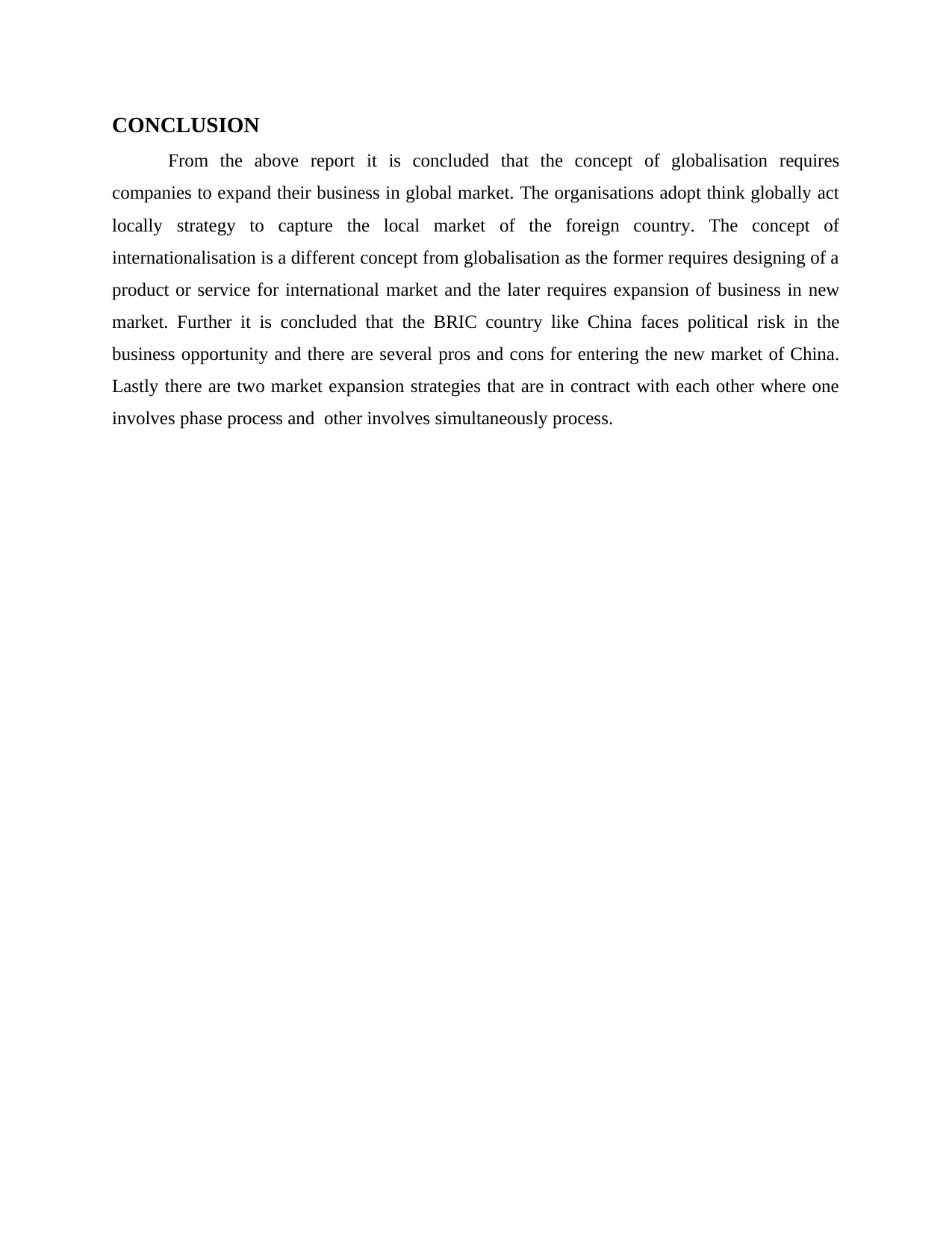
CONCLUSION
From the above report it is concluded that the concept of globalisation requires
companies to expand their business in global market. The organisations adopt think globally act
locally strategy to capture the local market of the foreign country. The concept of
internationalisation is a different concept from globalisation as the former requires designing of a
product or service for international market and the later requires expansion of business in new
market. Further it is concluded that the BRIC country like China faces political risk in the
business opportunity and there are several pros and cons for entering the new market of China.
Lastly there are two market expansion strategies that are in contract with each other where one
involves phase process and other involves simultaneously process.
From the above report it is concluded that the concept of globalisation requires
companies to expand their business in global market. The organisations adopt think globally act
locally strategy to capture the local market of the foreign country. The concept of
internationalisation is a different concept from globalisation as the former requires designing of a
product or service for international market and the later requires expansion of business in new
market. Further it is concluded that the BRIC country like China faces political risk in the
business opportunity and there are several pros and cons for entering the new market of China.
Lastly there are two market expansion strategies that are in contract with each other where one
involves phase process and other involves simultaneously process.

REFERENCES
Books and Journals
Cortellazzo, L., Bonesso, S. and Gerli, F., 2020. Entrepreneurs' behavioural competencies for
internationalisation. International Journal of Entrepreneurial Behavior & Research.
Grochal-Brejdak, M. and Szymura-Tyc, M., 2018. The Internationalisation Process of an E-
Commerce Entrepreneurial Firm: The Inward-Outward Internationalisation and the
Development of Knowledge. Entrepreneurial Business and Economics Review. 6(4).
p.103.
Harris, J., 2020. China–US Tensions: Is Globalisation Dead?. International Critical Thought.
10(2). pp.263-281.
Kandil, N., Battaïa, O. and Hammami, R., 2020. Globalisation vs. Slowbalisation: a literature
review of analytical models for sourcing decisions in supply chain management. Annual
Reviews in Control.
Kunizaki, M. and Yanagihara, M., 2017. Market Expansion by Advertising and a Mixed
Oligopoly. In The Theory of Mixed Oligopoly (pp. 191-206). Springer, Tokyo.
Liu, Y., 2018. The effects of competitors on new product launch and market expansion in the
hybrid car market. Empirical Economics. 55(4). pp.1849-1868.
Lo, W.Y.W. and Hou, A.Y.C., 2019. A farewell to internationalisation? Striking a balance
between global ambition and local needs in higher education in Taiwan. Higher
Education. pp.1-14.
Petreski, M., 2020. Winners or losers? Workers in transition economies under
globalisation. Post-Communist Economies. 32(4). pp.468-494.
Books and Journals
Cortellazzo, L., Bonesso, S. and Gerli, F., 2020. Entrepreneurs' behavioural competencies for
internationalisation. International Journal of Entrepreneurial Behavior & Research.
Grochal-Brejdak, M. and Szymura-Tyc, M., 2018. The Internationalisation Process of an E-
Commerce Entrepreneurial Firm: The Inward-Outward Internationalisation and the
Development of Knowledge. Entrepreneurial Business and Economics Review. 6(4).
p.103.
Harris, J., 2020. China–US Tensions: Is Globalisation Dead?. International Critical Thought.
10(2). pp.263-281.
Kandil, N., Battaïa, O. and Hammami, R., 2020. Globalisation vs. Slowbalisation: a literature
review of analytical models for sourcing decisions in supply chain management. Annual
Reviews in Control.
Kunizaki, M. and Yanagihara, M., 2017. Market Expansion by Advertising and a Mixed
Oligopoly. In The Theory of Mixed Oligopoly (pp. 191-206). Springer, Tokyo.
Liu, Y., 2018. The effects of competitors on new product launch and market expansion in the
hybrid car market. Empirical Economics. 55(4). pp.1849-1868.
Lo, W.Y.W. and Hou, A.Y.C., 2019. A farewell to internationalisation? Striking a balance
between global ambition and local needs in higher education in Taiwan. Higher
Education. pp.1-14.
Petreski, M., 2020. Winners or losers? Workers in transition economies under
globalisation. Post-Communist Economies. 32(4). pp.468-494.
⊘ This is a preview!⊘
Do you want full access?
Subscribe today to unlock all pages.

Trusted by 1+ million students worldwide
1 out of 9
Related Documents
Your All-in-One AI-Powered Toolkit for Academic Success.
+13062052269
info@desklib.com
Available 24*7 on WhatsApp / Email
![[object Object]](/_next/static/media/star-bottom.7253800d.svg)
Unlock your academic potential
Copyright © 2020–2025 A2Z Services. All Rights Reserved. Developed and managed by ZUCOL.



